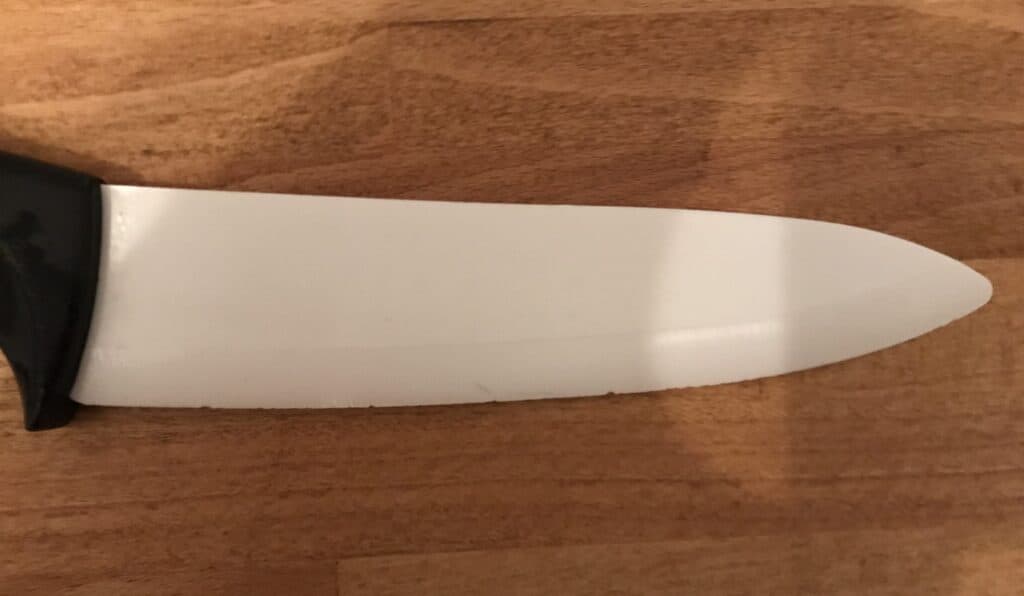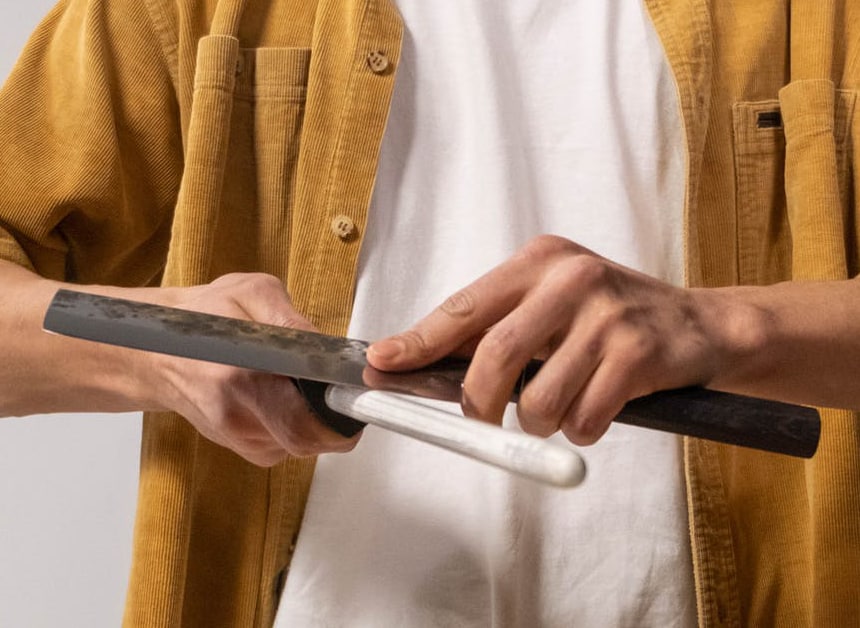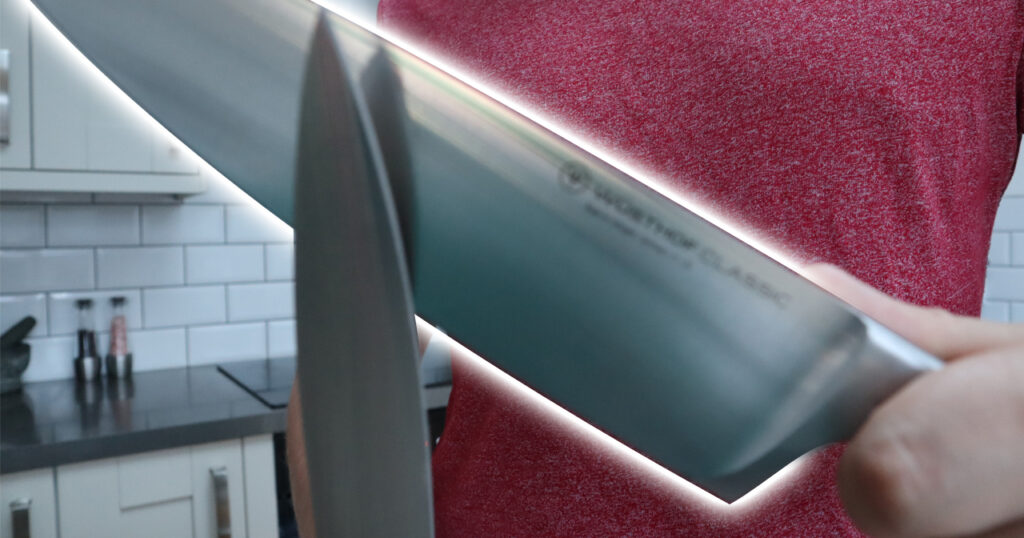
Ceramic knives have many benefits, they don’t rust, are extremely sharp and keep their sharp cutting edge for far longer than steel knives.
We all know that a normal steel knife will need to be sharpened from time to time, but how about their harder ceramic counterparts.
In this article, I’m going to take a look at ceramic knives and let you know whether they do need to be sharpened, how to sharpen them, and the tools you will need.
Ceramic knives do need to be sharpened, but far less frequently than steel knives do. Ceramic knives can maintain their edge for a long time but will eventually become dull or chipped. Ceramic is a very hard material and so only diamond-encrusted sharpening tools can be used to sharpen ceramic knives.
Can ceramic knives be sharpened

Ceramic knives will go blunt eventually, so if you want to keep using it then you will need to sharpen your ceramic knife.
Before you do there are some principles you will need to understand about sharpening.
Ceramic knife blades are particularly hard. This is one of their benefits as they stay sharp for longer than a standard steel knife would; however, it means that sharpening them can be a little more tricky than it is with a steel knife.
In principle, the sharpening process of any knife is quite simple.
To sharpen any knife you need a material harder than the knife itself to remove a thin layer of the knife blade, leaving in its place a perfectly fresh and sharp edge.
This is easier with steel where there are many materials that are harder, you can use a whetstone, diamond sharpening rod or ceramic sharpening rod to sharpen steel knives.
Ceramic knives are different. They are particularly hard, so if you try to use a whetstone to sharpen them you will end up causing more damage to the whetstone, and of course, you can’t use material of equal hardness like a ceramic rod.
This leaves just one option to sharpen a ceramic knife.
A ceramic knife can only be sharpened using a diamond-encrusted sharpener.
How to sharpen a ceramic knife
There are a few types of diamond sharpeners you can use to sharpen a ceramic knife.
Diamond sharpening rod
This is similar to other sharpening or honing rods you will see but it will be coated in a layer of diamond particles, allowing for a hard enough surface to file away a thin layer of your ceramic knife, unveiling the new sharp edge below.

Diamond sharpening stone
For a finer edge, you can use a diamond sharpening stone or plate. As with this rod, this item has a diamond particle layer that allows it to sharpen the ceramic blade without causing damage to the stone.
Pull-through diamond sharpener
You can also use a pull-through sharpener, personally I’m not a fan of these.
I prefer to have more control whilst sharpening and pull-through sharpeners have an already defined angle; however, their big benefit is that they are super easy to use.
How to keep ceramic knives sharp
Ceramic knives do need to be looked after very carefully if you want to keep them effective.
Ceramic knives are hard but they are also very brittle, and whilst they have the large advantage of never rusting they do have very strong disadvantages.
Due to their brittle nature, you have to be very careful about the way to clean and store your ceramic knives.
Whilst technically dishwasher safe, the environment in a dishwasher is not well suited for ceramic knives.
A ceramic knife can easily be rattled around in a dishwater and knocked against other utensils, causing damage to the blade.
Equally, you must be careful washing a ceramic knife in the kitchen sink, you don’t want to let it lie in the sink with other items.
The best way to clean a ceramic knife is by rinsing it in water and soap whilst keeping hold of it and wiping it dry.
You should store your ceramic knife in a place where it isn’t going to be at risk of chipping by hitting other utensils.
Placing your knife freely in a cutlery drawer is a recipe for a chipped blade as the motion of opening a shutting the drawer will cause the item to bang against the blade over time, causing little chips to appear.
I would recommend that you either purchase a ceramic knife with a storage block set. Or you purchase a ceramic knife that comes with its own blade sheath.
If you already have a ceramic knife but no sheath, use a cloth held by a rubber band as a DIY alternative.
My ceramic knife recommendations
I’ve written a detailed article featuring my personal ceramic knife recommendation. it has a range of knife types including ones with knife blacks and blade sheaths to make your knife last longer.
All the knives are made from quality ceramic from great manufactures and range in price from $30 to $100.
If you’re going to purchase a ceramic knife I highly recommend you check out my article here.
Benefits of ceramic knives
There some major benefits to using a ceramic knife when compared with a steel alternative. Here’s what I think the main ones are:
The blade is harder – Ceramic is harder than most steels, this means that the blade edge should take longer to wear down and therefore stay sharper for longer.
They don’t rust – Ceramic is completely stainless and won’t be affected by acid or water, therefore unlike steel knives, they have no risk of rusting.
They are lightweight – Ceramic is very lightweight which makes them easier to handle, especially for precise thin slicing.
Drawbacks of ceramic knives
There are also some pretty huge drawbacks to using a ceramic knife compare to a steel one, and sharpening difficulty is one of them. Here’s what I think the main ones are:
The blade chips easily – Whilst ceramic is very hard it is also very brittle. This means that ceramic knives are prone to chipping and even snapping in some cases. It’s advised that you only use ceramic knives to cut through soft fruit and vegetables. If ceramic knives are used to cut through meat there is a danger that the blade might be damaged by any bones in the meat. This is a significant disadvantage of ceramic knives and makes them much less of an all-round utility knife when compared with steel alternatives.
They are more difficult to sharpen – As I wrote earlier in the article, because ceramic is such a hard material you’re probably only going to be able to use a diamond sharpener to sharpen them. The act of sharpening itself is also more difficult than with most steel knives due to the hard nature of ceramic. This makes maintaining your knife quite difficult.
They are tricky to clean – Ceramic knives don’t rust, which is great in theory. But due to their brittle nature, it is advisable that you don’t clean your ceramic knife in the dishwasher or drop it into a soap-filled kitchen sink as you might do with other utensils. You should clean them by hand to ensure the blade isn’t damaged and ultimately I think this counteracts the benefit of being rust-free as cleaning and drying your steel knives by hand is the main prevention method of them rusting anyway.

